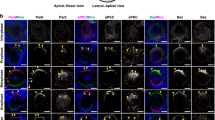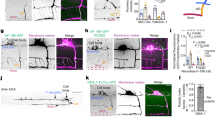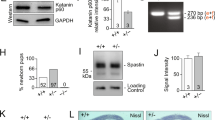Abstract
Neurons polarize to form elaborate multiple dendrites and one long axon. The establishment and maintenance of axon/dendrite polarity are fundamentally important for neurons. Recent studies have demonstrated that the polarity complex PAR-3–PAR-6–atypical protein kinase C (aPKC) is involved in polarity determination in many tissues and cells. The function of the PAR-3–PAR-6–aPKC protein complex depends on its subcellular localization in polarized cells. PAR-3 accumulates at the tip of growing axons in cultured rat hippocampal neurons, but the molecular mechanism of this localization remains unknown. Here we identify a direct interaction between PAR-3 and KIF3A, a plus-end-directed microtubule motor protein, and show that aPKC can associate with KIF3A through its interaction with PAR-3. The expression of dominant-negative PAR-3 and KIF3A fragments that disrupt PAR-3–KIF3A binding inhibited the accumulation of PAR-3 and aPKC at the tip of the neurites and abolished neuronal polarity. These results suggest that PAR-3 is transported to the distal tip of the axon by KIF3A and that the proper localization of PAR-3 is required to establish neuronal polarity.
This is a preview of subscription content, access via your institution
Access options
Subscribe to this journal
Receive 12 print issues and online access
$209.00 per year
only $17.42 per issue
Buy this article
- Purchase on Springer Link
- Instant access to full article PDF
Prices may be subject to local taxes which are calculated during checkout





Similar content being viewed by others
References
Craig, A.M. & Banker, G. Neuronal polarity. Annu. Rev. Neurosci. 17, 267–310 (1994).
Dotti, C.G., Sullivan, C.A. & Banker, G.A. The establishment of polarity by hippocampal neurons in culture. J. Neurosci. 8, 1454–1468 (1988).
Bradke, F. & Dotti, C.G. Establishment of neuronal polarity: lessons from cultured hippocampal neurons. Curr. Opin. Neurobiol. 10, 574–581 (2000).
Fukata, Y., Kimura, T. & Kaibuchi, K. Axon specification in hippocampal neurons. Neurosci. Res. 43, 305–315 (2002).
Kemphues, K. PARsing embryonic polarity. Cell 101, 345–348 (2000).
Jan, Y.N. & Jan, L.Y. Asymmetric cell division in the Drosophila nervous system. Nature Rev. Neurosci. 2, 772–779 (2001).
Ohno, S. Intercellular junctions and cellular polarity: the PAR–aPKC complex, a conserved core cassette playing fundamental roles in cell polarity. Curr. Opin. Cell Biol. 13, 641–648 (2001).
Shi, S.H., Jan, L.Y. & Jan, Y.N. Hippocampal neuronal polarity specified by spatially localized mPar-3–mPar-6 and PI 3-kinase activity. Cell 112, 63–75 (2003).
Lin, D. et al. A mammalian PAR-3–PAR-6 complex implicated in Cdc42/Rac1 and aPKC signalling and cell polarity. Nature Cell Biol. 2, 540–547 (2000).
Kondo, S. et al. KIF3A is a new microtubule-based anterograde motor in the nerve axon. J. Cell Biol. 125, 1095–1107 (1994).
Yamazaki, H., Nakata, T., Okada, Y. & Hirokawa, N. KIF3A/B: a heterodimeric kinesin superfamily protein that works as a microtubule plus end-directed motor for membrane organelle transport. J. Cell Biol. 130, 1387–1399 (1995).
Yang, Z. & Goldstein, L.S. Characterization of the KIF3C neural kinesin-like motor from mouse. Mol. Biol. Cell 9, 249–261 (1998).
Muresan, V. et al. KIF3C and KIF3A form a novel neuronal heteromeric kinesin that associates with membrane vesicles. Mol. Biol. Cell 9, 637–652 (1998).
Goldstein, L.S. & Yang, Z. Microtubule-based transport systems in neurons: the roles of kinesins and dyneins. Annu. Rev. Neurosci. 23, 39–71 (2000).
Lupas, A., VanDyke, M. & Stock, J. Predicting coiled coils from protein sequences. Science 252, 1162–1164 (1991).
Yamazaki, H., Nakata, T., Okada, Y. & Hirokawa, N. Cloning and characterization of KAP3: a novel kinesin superfamily-associated protein of KIF3A/3B. Proc. Natl Acad. Sci. USA 93, 8443–8448 (1996).
Takeda, S. et al. Kinesin superfamily protein 3 (KIF3) motor transports fodrin-associating vesicles important for neurite building. J. Cell Biol. 148, 1255–1265 (2000).
Jimbo, T. et al. Identification of a link between the tumour suppressor APC and the kinesin superfamily. Nature Cell Biol. 4, 323–327 (2002).
Akimoto, K. et al. EGF or PDGF receptors activate atypical PKCλ through phosphatidylinositol 3-kinase. EMBO J. 15, 788–798 (1996).
Izumi, Y. et al. An atypical PKC directly associates and co-localizes at the epithelial tight junction with ASIP, a mammalian homologue of Caenorhabditis elegans polarity protein PAR-3. J. Cell Biol. 143, 95–106 (1998).
Suzuki, A. et al. Atypical protein kinase C is involved in the evolutionarily conserved par protein complex and plays a critical role in establishing epithelia-specific junctional structures. J. Cell Biol. 152, 1183–1196 (2001).
Inagaki, N. et al. CRMP-2 induces axons in cultured hippocampal neurons. Nature Neurosci. 4, 781–782 (2001).
Fukata, Y. et al. CRMP-2 binds to tubulin heterodimers to promote microtubule assembly. Nature Cell Biol. 4, 583–591 (2002).
Acknowledgements
We thank M. Fukata, M. Nakagawa and J. Noritake for discussion; M. Yoshizaki and K. Fujii for preparing materials and technical assistance; T. Ishii for secretarial assistance. This research was supported by Grants-in-Aid for Scientific Research and Grant-in-Aid for Creative Scientific Research from the Ministry of Education, Culture, Sports, Science and Technology of Japan and the Organization for Pharmaceutical Safety and Research.
Author information
Authors and Affiliations
Corresponding author
Ethics declarations
Competing interests
The authors declare no competing financial interests.
Rights and permissions
About this article
Cite this article
Nishimura, T., Kato, K., Yamaguchi, T. et al. Role of the PAR-3–KIF3 complex in the establishment of neuronal polarity. Nat Cell Biol 6, 328–334 (2004). https://doi.org/10.1038/ncb1118
Received:
Accepted:
Published:
Issue Date:
DOI: https://doi.org/10.1038/ncb1118
This article is cited by
-
Loss of KAP3 decreases intercellular adhesion and impairs intracellular transport of laminin in signet ring cell carcinoma of the stomach
Scientific Reports (2022)
-
Multilayered regulations of alternative splicing, NMD, and protein stability control temporal induction and tissue-specific expression of TRIM46 during axon formation
Nature Communications (2022)
-
Oxidative stress induced by NOX2 contributes to neuropathic pain via plasma membrane translocation of PKCε in rat dorsal root ganglion neurons
Journal of Neuroinflammation (2021)
-
Whole genome sequencing of nearly isogenic WMI and WLI inbred rats identifies genes potentially involved in depression and stress reactivity
Scientific Reports (2021)
-
The polarity protein PARD3 and cancer
Oncogene (2021)



